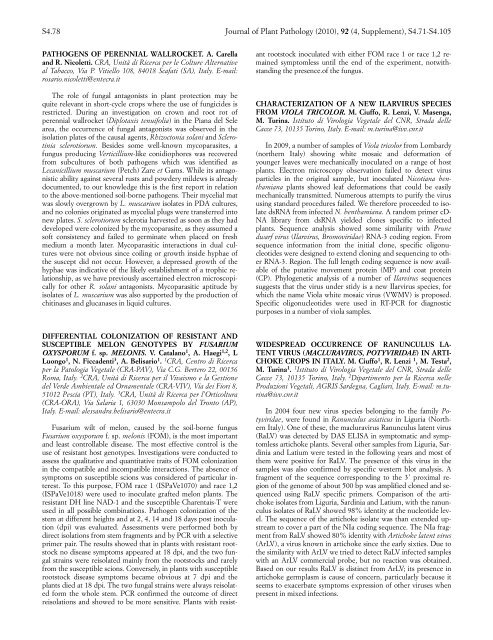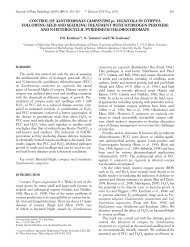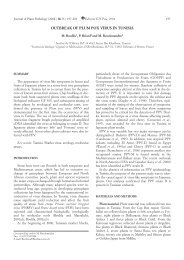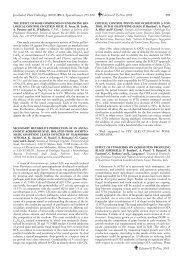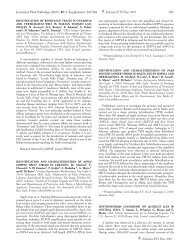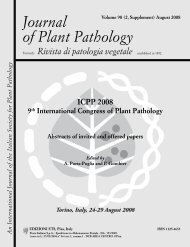Journal of Plant Pathology (2010), 92 (4, Supplement ... - Sipav.org
Journal of Plant Pathology (2010), 92 (4, Supplement ... - Sipav.org
Journal of Plant Pathology (2010), 92 (4, Supplement ... - Sipav.org
You also want an ePaper? Increase the reach of your titles
YUMPU automatically turns print PDFs into web optimized ePapers that Google loves.
S4.78 <strong>Journal</strong> <strong>of</strong> <strong>Plant</strong> <strong>Pathology</strong> (<strong>2010</strong>), <strong>92</strong> (4, <strong>Supplement</strong>), S4.71-S4.105<br />
PATHOGENS OF PERENNIAL WALLROCKET. A. Carella<br />
and R. Nicoletti. CRA, Unità di Ricerca per le Colture Alternative<br />
al Tabacco, Via P. Vitiello 108, 84018 Scafati (SA), Italy. E-mail:<br />
rosario.nicoletti@entecra.it<br />
The role <strong>of</strong> fungal antagonists in plant protection may be<br />
quite relevant in short-cycle crops where the use <strong>of</strong> fungicides is<br />
restricted. During an investigation on crown and root rot <strong>of</strong><br />
perennial wallrocket (Diplotaxis tenuifolia) in the Piana del Sele<br />
area, the occurrence <strong>of</strong> fungal antagonists was observed in the<br />
isolation plates <strong>of</strong> the causal agents, Rhizoctonia solani and Sclerotinia<br />
sclerotiorum. Besides some well-known mycoparasites, a<br />
fungus producing Verticillium-like conidiophores was recovered<br />
from subcultures <strong>of</strong> both pathogens which was identified as<br />
Lecanicillium muscarium (Petch) Zare et Gams. While its antagonistic<br />
ability against several rusts and powdery mildews is already<br />
documented, to our knowledge this is the first report in relation<br />
to the above-mentioned soil-borne pathogens. Their mycelial mat<br />
was slowly overgrown by L. muscarium isolates in PDA cultures,<br />
and no colonies originated as mycelial plugs were transferred into<br />
new plates. S. sclerotiorum sclerotia harvested as soon as they had<br />
developed were colonized by the mycoparasite, as they assumed a<br />
s<strong>of</strong>t consistency and failed to germinate when placed on fresh<br />
medium a month later. Mycoparasitic interactions in dual cultures<br />
were not obvious since coiling or growth inside hyphae <strong>of</strong><br />
the suscept did not occur. However, a depressed growth <strong>of</strong> the<br />
hyphae was indicative <strong>of</strong> the likely establishment <strong>of</strong> a trophic relationship,<br />
as we have previously ascertained electron microscopically<br />
for other R. solani antagonists. Mycoparasitic aptitude by<br />
isolates <strong>of</strong> L. muscarium was also supported by the production <strong>of</strong><br />
chitinases and glucanases in liquid cultures.<br />
DIFFERENTIAL COLONIZATION OF RESISTANT AND<br />
SUSCEPTIBLE MELON GENOTYPES BY FUSARIUM<br />
OXYSPORUM f. sp. MELONIS. V. Catalano 1 , A. Haegi 1,2 , L<br />
Luongo 1 , N. Ficcadenti 3 , A. Belisario 1 . 1 CRA, Centro di Ricerca<br />
per la Patologia Vegetale (CRA-PAV), Via C.G. Bertero 22, 00156<br />
Roma, Italy. 2 CRA, Unità di Ricerca per il Vivaismo e la Gestione<br />
del Verde Ambientale ed Ornamentale (CRA-VIV), Via dei Fiori 8,<br />
51012 Pescia (PT), Italy. 3 CRA, Unità di Ricerca per l’Orticoltura<br />
(CRA-ORA), Via Salaria 1, 63030 Monsampolo del Tronto (AP),<br />
Italy. E-mail: alessandra.belisario@entecra.it<br />
Fusarium wilt <strong>of</strong> melon, caused by the soil-borne fungus<br />
Fusarium oxysporum f. sp. melonis (FOM), is the most important<br />
and least controllable disease. The most effective control is the<br />
use <strong>of</strong> resistant host genotypes. Investigations were conducted to<br />
assess the qualitative and quantitative traits <strong>of</strong> FOM colonization<br />
in the compatible and incompatible interactions. The absence <strong>of</strong><br />
symptoms on susceptible scions was considered <strong>of</strong> particular interest.<br />
To this purpose, FOM race 1 (ISPaVe1070) and race 1,2<br />
(ISPaVe1018) were used to inoculate grafted melon plants. The<br />
resistant DH line NAD-1 and the susceptible Charentais-T were<br />
used in all possible combinations. Pathogen colonization <strong>of</strong> the<br />
stem at different heights and at 2, 4, 14 and 18 days post inoculation<br />
(dpi) was evaluated. Assessments were performed both by<br />
direct isolations from stem fragments and by PCR with a selective<br />
primer pair. The results showed that in plants with resistant rootstock<br />
no disease symptoms appeared at 18 dpi, and the two fungal<br />
strains were reisolated mainly from the rootstocks and rarely<br />
from the susceptible scions. Conversely, in plants with susceptible<br />
rootstock disease symptoms became obvious at 7 dpi and the<br />
plants died at 18 dpi. The two fungal strains were always reisolated<br />
form the whole stem. PCR confirmed the outcome <strong>of</strong> direct<br />
reisolations and showed to be more sensitive. <strong>Plant</strong>s with resist-<br />
ant rootstock inoculated with either FOM race 1 or race 1,2 remained<br />
symptomless until the end <strong>of</strong> the experiment, notwithstanding<br />
the presence.<strong>of</strong> the fungus.<br />
CHARACTERIZATION OF A NEW ILARVIRUS SPECIES<br />
FROM VIOLA TRICOLOR. M. Ciuffo, R. Lenzi, V. Masenga,<br />
M. Turina. Istituto di Virologia Vegetale del CNR, Strada delle<br />
Cacce 73, 10135 Torino, Italy. E-mail: m.turina@ivv.cnr.it<br />
In 2009, a number <strong>of</strong> samples <strong>of</strong> Viola tricolor from Lombardy<br />
(northern Italy) showing white mosaic and deformation <strong>of</strong><br />
younger leaves were mechanically inoculated on a range <strong>of</strong> host<br />
plants. Electron microscopy observation failed to detect virus<br />
particles in the original sample, but inoculated Nicotiana benthamiana<br />
plants showed leaf deformations that could be easily<br />
mechanically transmitted. Numerous attempts to purify the virus<br />
using standard procedures failed. We therefore proceeded to isolate<br />
dsRNA from infected N. benthamiana. A random primer cD-<br />
NA library from dsRNA yielded clones specific to infected<br />
plants. Sequence analysis showed some similarity with Prune<br />
dwarf virus (Ilarvirus, Bromoviridae) RNA-3 coding region. From<br />
sequence information from the initial clone, specific oligonucleotides<br />
were designed to extend cloning and sequencing to other<br />
RNA-3. Region. The full length coding sequence is now available<br />
<strong>of</strong> the putative movement protein (MP) and coat protein<br />
(CP). Phylogenetic analysis <strong>of</strong> a number <strong>of</strong> Ilarvirus sequences<br />
suggests that the virus under stidy is a new Ilarvirus species, for<br />
which the name Viola white mosaic virus (VWMV) is proposed.<br />
Specific oligonucleotides were used in RT-PCR for diagnostic<br />
purposes in a number <strong>of</strong> viola samples.<br />
WIDESPREAD OCCURRENCE OF RANUNCULUS LA-<br />
TENT VIRUS (MACLURAVIRUS, POTYVIRIDAE) IN ARTI-<br />
CHOKE CROPS IN ITALY. M. Ciuffo 1 , R. Lenzi 1 , M. Testa 2 ,<br />
M. Turina 1 . 1 Istituto di Virologia Vegetale del CNR, Strada delle<br />
Cacce 73, 10135 Torino, Italy. 2 Dipartimento per la Ricerca nelle<br />
Produzioni Vegetali, AGRIS Sardegna, Cagliari, Italy. E-mail: m.turina@ivv.cnr.it<br />
In 2004 four new virus species belonging to the family Potyviridae,<br />
were found in Ranunculus asiaticus in Liguria (Northern<br />
Italy). One <strong>of</strong> these, the macluravirus Ranunculus latent virus<br />
(RaLV) was detected by DAS ELISA in symptomatic and symptomless<br />
artichoke plants. Several other samples from Liguria, Sardinia<br />
and Latium were tested in the following years and most <strong>of</strong><br />
them were positive for RaLV. The presence <strong>of</strong> this virus in the<br />
samples was also confirmed by specific western blot analysis. A<br />
fragment <strong>of</strong> the sequence corresponding to the 3’ proximal region<br />
<strong>of</strong> the genome <strong>of</strong> about 500 bp was amplified cloned and sequenced<br />
using RaLV specific primers. Comparison <strong>of</strong> the artichoke<br />
isolates from Liguria, Sardinia and Latium, with the ranunculus<br />
isolates <strong>of</strong> RaLV showed 98% identity at the nucleotide level.<br />
The sequence <strong>of</strong> the artichoke isolate was than extended upstream<br />
to cover a part <strong>of</strong> the NIa coding sequence. The NIa fragment<br />
from RaLV showed 80% identity with Artichoke latent virus<br />
(ArLV), a virus known in artichoke since the early sixties. Due to<br />
the similarity with ArLV we tried to detect RaLV infected samples<br />
with an ArLV commercial probe, but no reaction was obtained.<br />
Based on our results RaLV is distinct from ArLV; its presence in<br />
artichoke germplasm is cause <strong>of</strong> concern, particularly because it<br />
seems to exacerbate symptoms expression <strong>of</strong> other viruses when<br />
present in mixed infections.


